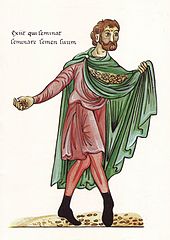Parable of the fourfold field
The parable of the fourfold field is a parable from the Gospels according to Mark , Matthew and Luke .
content

The parable is given by all three Synoptics with Mark, Matthew and Luke . Jesus speaks in front of a large crowd, with Mark and Matthew he sits in a boat while the crowd on the bank listens. The version from the Gospel of Mark reads:
"Listen! Behold, the sower went out to sow. And it came to pass, while he was sowing, that one fell by the way, and the birds came and ate it up. And other things fell on the stony where there was not much earth; and it rose immediately, because it was not deep in soil. And when the sun came up it was burned and because it had no root it withered. And other fell under the thorns; and the thorns sprouted and choked it, and there was no fruit. And other fell into the good earth and gave fruit, sprouting and growing; and it bore one thirty, one sixty, and one hundred times. And he said: He who has ears to hear, let him hear! "
When his apostles (after Mark also "those who were around him, including the twelve") ask why he was speaking in riddles, he replied that he was doing this because few wanted or could understand God's message. According to the version of Matthew, he adds that Isaiah had already prophesied that the other people would see them but not recognize them, hear them but not understand and close their hearts. On the other hand, he said of his disciples: Blessed are your eyes, that they see, and your ears, that they hear; for verily I say to you, many prophets and righteous people have longed to see what you are looking at and have not seen it; and hear what you hear and have not heard it.
Then he explains the meaning of the parable: The scattered seed is the word of God . Those for whom there is no fruit are the road, the rocky ground and the thorns. With the first Satan come and take away the seed, with the second the seedling withers because it has no reason and with the third it would be overgrown with worries and desires. However, those who heard and understood the word and took it to heart permanently are good soil.
interpretation
The fruit metaphor says that the word of God as a seed needs time to germinate and grow. It can only thrive in “good soil”, that is, a willing person. However, being “bad soil” is not fate, as the similar parable of the fig tree in Luke's Gospel suggests. There the owner of a vineyard wants to cut down a fruitless fig tree. However, the vintner asks for a year, because first he wants to dig around the tree and fertilize it. The final sentence “He who has ears to hear, hear” is a call to become “good soil”.
reception
The Hortus Deliciarum (Eng .: Garden of Delicacies ), the first documented encyclopedia written by a woman, Herrad von Landsberg , in the late 12th century , presents the parable in miniature in his handwriting (see pictures above).
The earliest dated painting by Pieter Bruegel the Elder, River Landscape with a Sower in the Timken Museum of Art , San Diego , illustrates this parable.
- poetry
The poet lawyer David Denicke (1603–1680) composed the chorale Herr, for your word be highly praised for the parable (1659, EG 196). Johann Sebastian Bach created the cantata Leicht-minded Flattergeister (BWV 181) in 1724 , the text of which by an unknown poet is closely based on the parable.
See also
Individual evidence
- ↑ Mk 4,3-20 ELB
- ↑ Mt 13 : 3–20 ELB
- ↑ Lk 8.5-15 ELB
- ↑ Mk 4,3-9 ESV
- ↑ Mt 13:16 ELB
- ↑ Lk 13 : 6-9 ESV
- ↑ Christian Stettler : The last court. Studies on the Expectation of the Last Judgment from the Scriptures to Jesus. Mohr Siebeck 2011 ISBN 978-3-16-150512-6 pp. 257f
- ^ Christian Vöhringer: Pieter Bruegel. 1525 / 30-1569 , Tandem Verlag (hfullmann Imprint) ISBN 978-3-8331-3852-2 p. 28 ff. Chapter Early Paintings


